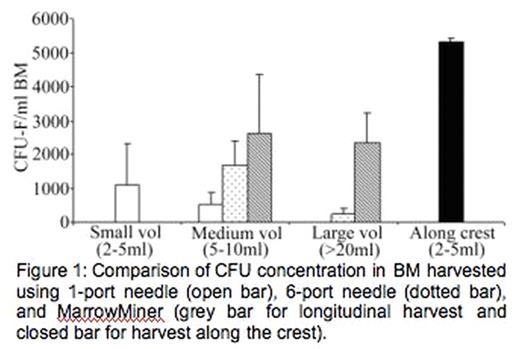Abstract
INTRODUCTION: Bone marrow (BM) contains a rich supply of adult stem & progenitor cells. Traditional percutaneous large bore needle aspiration methods for harvesting marrow for bone marrow transplantation (BMT) are crude, tedious and expensive usually requiring general anesthesia. A novel device, the MarrowMiner (MM), was developed for the minimally invasive harvest of BM which may enable the rapid, convenient outpatient harvest of large quantities of BM derived cells under local anesthesia for use in BMT and an increasing array of developing marrow based regenerative therapies. The MarrowMiner utilizes a single marrow entry site into the iliac bone, through which the flexible, powered, MM catheter is able to access the majority of the accessible marrow space and aspirate rich marrow. The device has been tested extensively in human cadavers and in large animal trials.
METHODS: In 5 juvenile pigs (70–87kg), standard 1- and 6-port needles were used to aspirate marrow at three locations along one iliac crest. On the opposite iliac, the MM device was used to collect BM either along the crest or longitudinally down the plane of the iliac wing. Harvests were collected in: small (2–5ml), medium (5–20ml), & large (>20ml) volumes. BM cell viability, counts & CFU-F assays were performed.
RESULTS: The MM was observed to be safe, and despite long aspiration paths (up to 20cm), the catheter remained within the marrow cavity without penetrating the cortical walls. Marrow volumes >60 ml could be aspirated in a single pass using either a syringe or vacuum suction. No significant differences were observed in viability, or nucleated cell concentration among BM harvested by 1-port, 6-port needles, and MM in a longitudinal manner, with the exception that BM aspirated along the iliac crest by the MM contained a higher concentration of nucleated cells (p<.05). As expected, the CFU-F concentration decreased with increasing BM volume harvested when standard harvest needles were used. In contrast, no significant decrease in CFU concentration was observed with increasing marrow volume aspirates with the MM (Figure 1). The MM yielded significantly higher CFU concentration than the standard 1-port and 6-port aspiration needles at the medium harvest volume. When a large volume of marrow was aspirated, MM harvested significantly higher [9 fold increase] in CFU-F concentration than the 6-port needle. As aspiration volume increased from medium to large, MM aspirate maintained CFU concentration while the 6-port needle resulted in an approximately 7.5 fold reduction. Marrow aspirated along the crest yielded significantly higher concentrations of CFU-F.
CONCLUSIONS: The study demonstrated that the MM can successfully & safely harvest large volumes of BM, with significantly higher stem cell content than traditional needle aspiration. The flexible shaft allowed for aspirating bone marrow of the highest cellularity along the iliac crest, a path unfeasible for rigid needles. This study suggests that this novel device may enable significantly improved clinical BM harvest in a more rapid, reproducible and less invasive manner, particularly if directed to harvest along the iliac crest.
Comparison of CFU concentration in BM harvested using 1-port needle (open bar), 6-port needle (dotted bar), and MarrowMiner (grey bar for longitudinal harvest and closed bar for harvest along the crest).
Comparison of CFU concentration in BM harvested using 1-port needle (open bar), 6-port needle (dotted bar), and MarrowMiner (grey bar for longitudinal harvest and closed bar for harvest along the crest).
Author notes
Disclosure:Consultancy: D. Kraft is inventor of the MarrowMiner, minimally invasive harvest device, and is a consultant to StemCor Systems Inc. Ownership Interests: Stock ownership in start-up. Membership Information: SAB member.


This feature is available to Subscribers Only
Sign In or Create an Account Close Modal